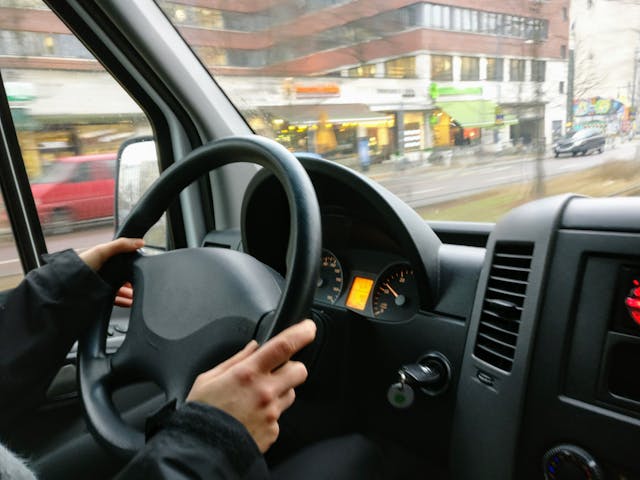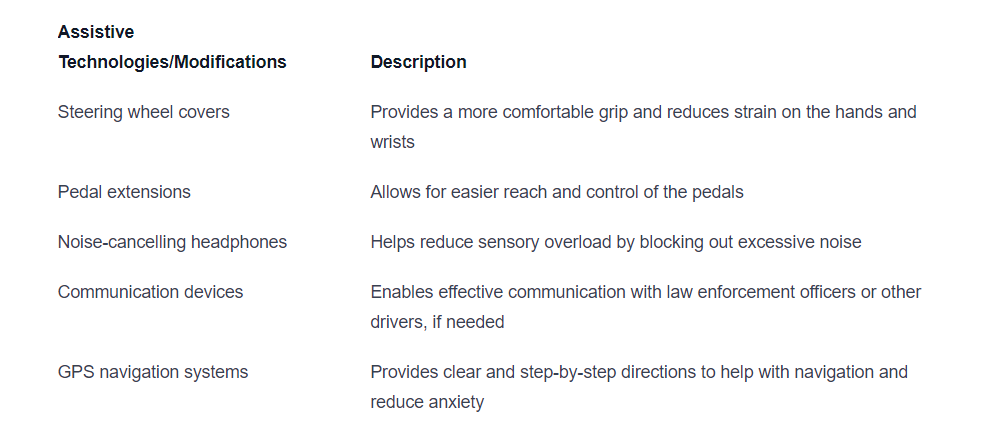Autistic People Can Drive: Here's What They Need to Know
Driving with autism: Discover the possibilities and overcome challenges. Learn strategies and find support for autistic drivers.

Autistic People and Driving
Autistic individuals have often faced stereotypes and misconceptions when it comes to their ability to drive. However, it's important to challenge these preconceived notions and recognize that autistic people can indeed drive, given the necessary support and understanding. In this section, we will explore the possibilities for autistic drivers and debunk some common misconceptions.

Challenging Stereotypes and Misconceptions
There is a common misconception that individuals with autism lack the skills and abilities required for safe driving. However, research and real-life experiences have shown that autistic people can become competent and responsible drivers. It is crucial to recognize that autism is a spectrum disorder, and each individual's abilities and challenges may vary.
Autistic individuals often possess unique strengths that can contribute to safer driving. These strengths may include attention to detail, adherence to rules, and heightened focus. By understanding and leveraging these strengths, autistic drivers can navigate the roadways effectively.
Exploring the Possibilities
For autistic individuals, driving can open up a world of possibilities and independence. It provides them with the freedom to travel, pursue employment opportunities, and engage in social activities. Driving can enhance their quality of life and empower them to lead more fulfilling and autonomous lives.
While driving may present challenges for some autistic individuals, it's important to remember that with the right support, training, and accommodations, many can overcome these challenges and become safe and confident drivers. It is crucial to approach the topic of autistic individuals and driving with an open mind, recognizing their potential and focusing on their individual abilities.
By challenging stereotypes and misconceptions and exploring the possibilities, we can create a more inclusive and understanding society that supports autistic individuals in their journey to become independent drivers. The road to driving success for autistic individuals starts with education, awareness, and the provision of appropriate resources and support.
Understanding Autism and Driving
To truly grasp the relationship between autism and driving, it's important to have a basic understanding of Autism Spectrum Disorder (ASD) and how it affects individuals. By gaining insight into the unique characteristics of autism, we can better evaluate the driving skills and abilities of autistic individuals.
Autism Spectrum Disorder (ASD) Basics
Autism Spectrum Disorder (ASD) is a neurodevelopmental disorder that affects social interaction, communication, and behavior. It is a spectrum disorder, meaning that it varies in severity and presentation from person to person. Some individuals with ASD may have difficulties with social skills, sensory sensitivities, and repetitive behaviors.
It's crucial to recognize that autism is a diverse condition, and each autistic individual has their own strengths and challenges. Some individuals with autism may excel in specific areas, such as attention to detail or visual thinking, which can be beneficial in driving situations. However, others may struggle with executive functioning, impulse control, or interpreting social cues, which can present challenges on the road.
Evaluating Driving Skills and Abilities in Autistic Individuals
When considering whether an autistic individual can drive, it's important to conduct a thorough evaluation of their driving skills and abilities. This evaluation should be performed by professionals experienced in assessing individuals with neurodevelopmental conditions, such as occupational therapists or driving rehabilitation specialists.
The evaluation process typically involves a combination of assessments, interviews, and on-road evaluations. The goal is to assess the individual's cognitive abilities, visual perception, motor skills, attention, and ability to follow traffic rules and regulations. The evaluation may also consider the individual's ability to manage distractions, cope with unexpected situations, and adapt to changes on the road.
It is important to note that the evaluation should be tailored to the individual's specific needs and strengths. The focus should be on identifying any areas of difficulty and developing strategies or accommodations to support safe driving.
By understanding the basics of Autism Spectrum Disorder (ASD) and conducting thorough evaluations, we can gain valuable insights into the driving skills and abilities of autistic individuals. This knowledge can help inform decisions about whether an autistic individual is ready to drive and what additional support or accommodations may be beneficial for them on the road.
Potential Challenges for Autistic Drivers
While autistic individuals can drive and enjoy the independence and freedom that comes with it, there are some potential challenges they may face on the road. It's crucial to understand these challenges and develop strategies to overcome them for a safe driving experience.
Sensory Overload and Distractions
Sensory processing differences can make autistic drivers more susceptible to sensory overload while driving. Bright lights, loud noises, and strong smells can be overwhelming, leading to difficulty concentrating on the road. Additionally, distractions inside the vehicle, such as radios or conversations, can also disrupt focus.
To mitigate these challenges, autistic drivers can consider the following strategies:
- Sensory accommodations: Modifying the vehicle's environment by using sunglasses to reduce glare, noise-cancelling headphones to minimize auditory distractions, and air fresheners with calming scents.
- Managing internal distractions: Limiting conversations with passengers or using visual cues, such as a "Do Not Disturb" sign, to indicate the need for a quiet driving environment.
- Planning routes: Avoiding areas with known sensory triggers, such as crowded streets or construction zones, to reduce the likelihood of overload.
Difficulty with Social Interactions and Communication on the Road
Autistic individuals may experience challenges related to social interactions and communication while driving. Non-verbal cues, such as eye contact or hand signals, can be difficult to interpret, leading to potential misunderstandings with other drivers. Additionally, navigating complex traffic situations that require quick decision-making can be stressful.
To address these challenges, autistic drivers can consider the following strategies:
- Developing communication techniques: Using clear and direct communication signals, such as using turn signals well in advance and maintaining consistent speed and lane position, to convey intentions to other drivers.
- Driving in less complex environments: Initially, practicing driving in quieter and less congested areas to build confidence and gradually progressing to more challenging driving situations.
- Utilizing technology: Taking advantage of GPS navigation systems and adaptive technologies, such as lane departure warning systems or collision avoidance systems, to assist with navigation and safety on the road.
By recognizing and addressing these potential challenges, autistic drivers can enhance their driving experience and feel more confident on the road. It's important to remember that each individual's experience may vary, and finding personalized coping mechanisms and strategies is vital. Seeking guidance from driver's education programs and adaptive driving instructors can provide valuable support in navigating these challenges and ensuring a safe and enjoyable driving journey.
Strategies for Successful Driving
For autistic individuals who aspire to drive, there are strategies and techniques that can contribute to a successful driving experience. By adequately preparing for the driving experience and developing coping mechanisms, autistic drivers can navigate the road with confidence and safety.
Preparing for the Driving Experience
Before getting behind the wheel, it is essential for autistic individuals to engage in thorough preparation. This includes:
- Education and Training: Participating in driver's education programs specifically designed for individuals with autism can provide valuable knowledge and skills. These programs often focus on understanding traffic rules, road signs, and safe driving practices.
- Gradual Exposure: Gradually exposing oneself to driving-related stimuli can help reduce anxiety and build confidence. This can involve visiting driving school locations, observing driving lessons, or taking practice drives in low-traffic areas.
- Establishing a Routine: Creating a routine and familiarizing oneself with the driving process can help reduce stress and anxiety. This can involve practicing specific driving routes, becoming familiar with vehicle controls, and developing a pre-driving checklist.
Developing Coping Mechanisms and Techniques
To address challenges that may arise while driving, autistic individuals can develop coping mechanisms and techniques. Some strategies that can be helpful include:
- Sensory Regulation: Autistic individuals may experience sensory overload while driving due to various stimuli. Using calming techniques like deep breathing, listening to soothing music, or wearing noise-canceling headphones can help manage sensory input and maintain focus on the road.
- Visual Supports: Utilizing visual supports, such as GPS navigation systems with clear directions and visual diagrams, can aid in spatial awareness and navigation. Additionally, using visual reminders or checklists for important driving tasks can help maintain organization and reduce anxiety.
- Social Scripts: Difficulties with social interactions and communication on the road can be addressed through the use of social scripts. These scripts provide pre-planned responses and actions for common driving situations, ensuring clear communication with other drivers, pedestrians, and law enforcement if necessary.
- Time Management: Planning and allowing for extra time to reach destinations can help reduce the pressure of time constraints. This can alleviate stress and provide a more relaxed driving experience.
By implementing these strategies and techniques, autistic individuals can enhance their driving skills, manage potential challenges, and increase confidence on the road. It is important to remember that each individual is unique, and finding the strategies that work best for them is key to a successful driving experience.
Seeking Support and Resources
For autistic individuals who are interested in driving, there are various support systems and resources available to help them navigate the road safely and confidently. These resources include driver's education programs and adaptive driving instructors, as well as assistive technologies and modifications for vehicles.
Driver's Education Programs and Adaptive Driving Instructors
Driver's education programs play a crucial role in providing comprehensive training and guidance to individuals with autism who want to learn how to drive. These programs are designed to address the unique challenges and needs of autistic drivers, helping them develop the necessary skills and confidence on the road.
Adaptive driving instructors are trained professionals who specialize in working with individuals with disabilities, including autism. These instructors understand the specific requirements of autistic drivers and can tailor their teaching methods to accommodate their learning styles and individual needs. They provide personalized instruction and support, helping autistic drivers build their driving skills while also addressing any challenges they may encounter.
It is important for autistic individuals seeking driving support to research and find driver's education programs and adaptive driving instructors who have experience working with individuals on the autism spectrum. These professionals can provide the guidance and understanding necessary for a successful driving experience.
Assistive Technologies and Modifications for Vehicles
In addition to driver's education programs and adaptive driving instructors, there are various assistive technologies and modifications available to make driving more accessible and comfortable for autistic individuals. These technologies and modifications can help address specific challenges that autistic drivers may face, such as sensory overload or difficulties with communication.
Some common examples of assistive technologies and modifications include:

These assistive technologies and modifications are designed to enhance the driving experience for autistic individuals, promoting safety and independence on the road.
By utilizing driver's education programs, adaptive driving instructors, and assistive technologies/modifications, autistic individuals can acquire the necessary skills, support, and resources to confidently navigate the world of driving. It is essential to explore these options and tailor them to individual needs, ensuring a positive and empowering driving experience for autistic drivers.
Seeking Support and Resources
Driver's Education Programs and Adaptive Driving Instructors
For autistic individuals who are considering driving, seeking support and resources can greatly enhance their driving experience. Driver's education programs specifically designed for individuals with autism can provide valuable guidance and instruction tailored to their unique needs.
These specialized programs often include comprehensive training on driving skills, road safety, and traffic rules. They may also incorporate strategies to help individuals with autism manage challenges they may encounter on the road, such as sensory sensitivities or difficulties with social interactions. The instructors in these programs have expertise in working with autistic individuals and can provide the necessary support and accommodations.
In addition to driver's education programs, autistic individuals may benefit from working with adaptive driving instructors. These instructors have experience in teaching individuals with disabilities and can adapt their teaching methods to cater to the specific needs of autistic learners. They can provide personalized instruction, guidance, and support throughout the learning process, ensuring that the individual feels comfortable and confident behind the wheel.
Assistive Technologies and Modifications for Vehicles
To further support autistic individuals in their driving endeavors, there are various assistive technologies and vehicle modifications available. These tools and modifications aim to enhance safety, comfort, and ease of driving for individuals with autism.
One example of assistive technology is the use of visual aids, such as GPS navigation systems with clear visual directions. These aids can help individuals with autism navigate unfamiliar routes and reduce anxiety related to getting lost. Additionally, sensory modifications, such as noise-canceling headphones or special seat covers, can help minimize sensory overload and distractions while driving.
Vehicle modifications can also play a significant role in improving the driving experience for autistic individuals. For instance, adaptive controls, such as hand controls or pedal extensions, can be installed to accommodate individuals with physical challenges. These modifications allow individuals to operate the vehicle comfortably and safely, regardless of their specific needs.
It is important for autistic individuals to consult with professionals, such as occupational therapists or driving rehabilitation specialists, to determine the most suitable assistive technologies and vehicle modifications for their specific requirements. These professionals can assess the individual's needs and recommend appropriate solutions to optimize their driving experience.
By seeking support from driver's education programs, adaptive driving instructors, and utilizing assistive technologies and vehicle modifications, autistic individuals can enhance their driving skills, overcome challenges, and confidently navigate the roads. These resources and adaptations can empower autistic individuals to lead independent lives and enjoy the freedom and opportunities that driving can provide.
Sources
https://www.autismparentingmagazine.com/can-autistic-people-drive/
https://ibcces.org/blog/2020/07/02/driving-car-autism-different/
https://www.healthline.com/health/autism/can-autistic-people-drive
Similar articles
We’re here to help you

Our team is here to assist you in this process. Contact us for any assistance.
it’s easy to apply
We Accept Most Insurances
Our in-network insurance partnerships make ABA therapy more accessible to families throughout our service areas.







Our Insurance Process
We'll request your insurance details to help us verify your plan's coverage for ABA therapy. Once we've received this information, we'll walk you through your benefits, including copayments, deductibles and out-of-pocket maximums, so you know what to expect in advance.
Our team will then handle the preauthorization and all the necessary paperwork.
.svg)





















.jpeg)


































.jpeg)




.jpeg)







.jpeg)











.jpeg)
















